The New Year is all about new beginnings. It’s a time to reflect on your accomplishments over the last 12 months and how you want to better yourself moving forward. And while many people focus on losing weight, starting a hobby, or saving money, did you know that a remote job can help you do all three? In addition to beginning a work from home job, you have the advantages of work-life balance and flexibility, giving you the time to work on the other interests and aspects of your life. But if you’ve never been in a remote position and want to make the transition, the task can seem overwhelming. That’s why you need a remote job search strategy. With this multipronged plan, you can focus on the important facets of your life while moving forward with an amazing work from home career.
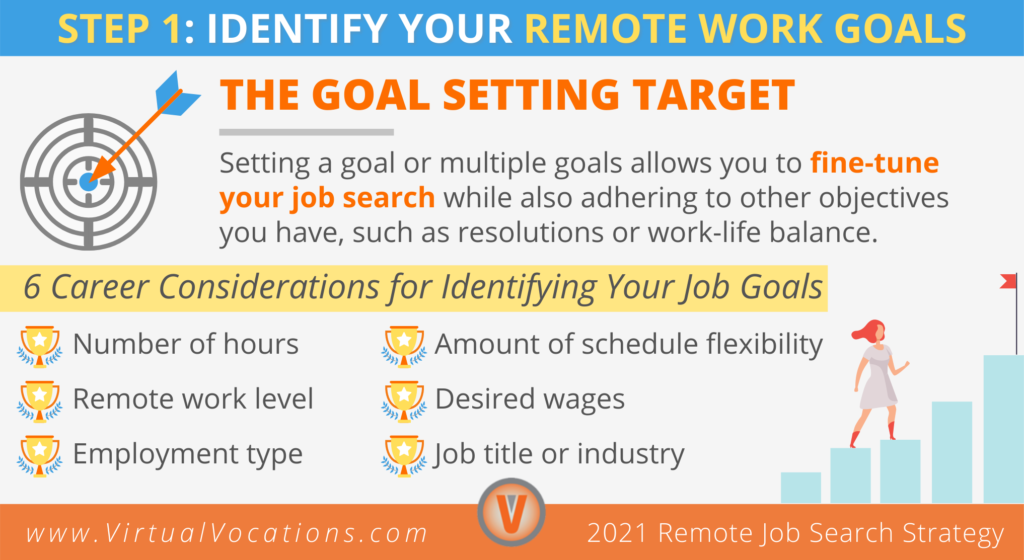
Identifying Your Goals
Identifying your goals is the first step on your remote job search strategy for 2021 and with good reason. Setting a goal or multiple goals allows you to fine-tune your job search. And it also gives you time to adhere to other objectives you have, such as resolutions or work-life balance. But identifying goals for your remote job search isn’t just creating a blanket statement. It takes specificity and precision.
As a result, making a goal such as “I want to find a remote IT job” isn’t quite concrete enough. You need to have all the finer points figured out. Therefore, you should also include the following in the goal identification step of your remote job search strategy:
- Full-time, part-time, or contract work, as well as a ballpark for the number of hours
- Whether you want to make a 100% transition to remote work or a part-time gig to feel it out
- Freelance, contractor, or employee
- Set schedule or flexible hours
- Pay rates
- Specific job title or at least an industry
While this may seem daunting, Virtual Vocations can streamline this process. By using the job filters in our remote database, you can narrow your job scope and find exactly the types of jobs you want.
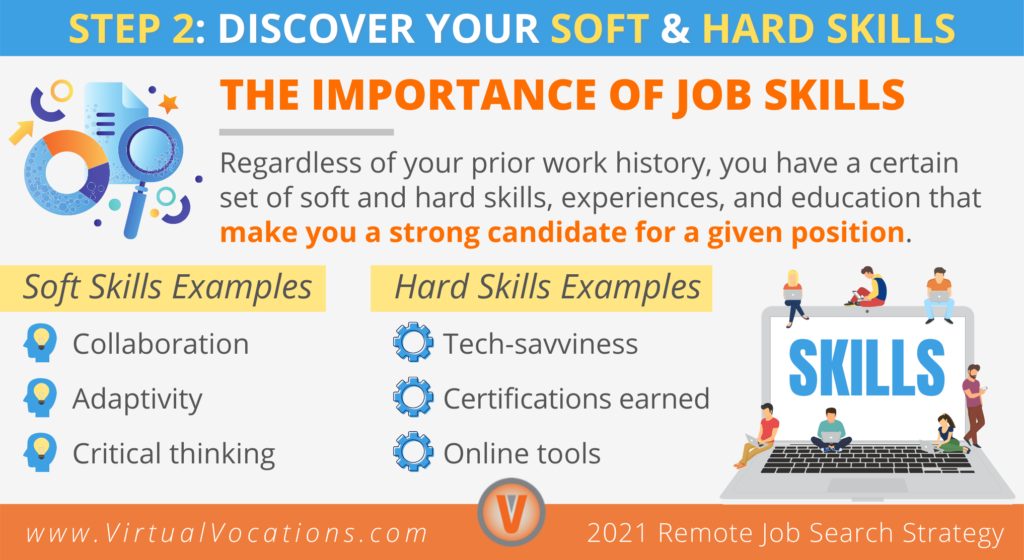
Discover Your Skills
Regardless of your prior work history, you have a certain set of soft and hard skills, experiences, and education that make you a strong candidate for a given position. However, discovering and identifying your skill set isn’t always simple.
This is often for three reasons. First, you may have never worked remotely. As a result, finding transferable skills or an overlap between onsite and remote work skills requires some extra thought. Second, your mind can play tricks on you. If you’ve been furloughed, out of work, or you were laid off, you may have taken it personally. Consequently, this can lower your morale and drive. But that doesn’t mean you lack the sought-after skills that many employers covet. Lastly, a transition in careers or industries can leave you scrambling to determine your transferable skills—much like when you switch from onsite to remote work.
How To Identify Soft Skills
Soft skills are defined as characteristics that allow you to solve problems and interact well with co-workers and colleagues. And though identifying them may seem arduous, simply listing a few can help jog your memory. Here are some high-demand soft skills you’ll often find on job descriptions in the remote field.
- Collaboration
- Adaptivity (especially crucial to remote work)
- Critical Thinking
- Emotional Intelligence
- Great written and oral communication
- Creativity
Keep in mind that these aren’t the only soft skills you may possess. But thinking critically about what skills you have and how to verbalize them in an interview or write them in a resume is a crucial part of your remote job search strategy.
How to Identify Hard Skills
Hard skills, or learned traits acquired through learning and experience, are much easier to identify than soft skills. Very simply, you should consider the day-to-day tasks you were responsible for at your previous jobs. If you’re a fresh college graduate, your hard skills could be defined by your coursework. Either way, the problem of identification still arises when you’re transitioning from onsite to remote work. But here are some transferable hard skills you may not have thought about:
- Tech-savviness
- Familiarity with online tools (Microsoft Office, Google Suite, Zoom, etc.)
- Sales
- Management
- Certifications you’ve earned or skill assessments you’ve passed
- College degrees
If you’re still having issues identifying your hard skills, take a peek at LinkedIn’s Most In-Demand Skills of 2020 for some inspiration.
Quantifying Experiences and Education
Once you’ve put together a basic outline of your soft skills and hard skills, the final step of discovering the entirety of your skill set is to quantify your experiences and/or education. Essentially, this is your chance to brag a little bit about yourself. For example, if you’re a salesperson, talk about how you boosted sales by 17% last quarter. Or if you’re a college student, quantify your education by stating you graduated magna cum laude or list your GPA. The overarching intention is to showcase what you can bring to your new employer through your professional, educational, and even life experiences.
Bring It All Together
After discovering all of your skills and quantifying your experiences, bring them all together by writing a “Career Story.” Imagine that you’re writing a biography about your career, your aspirations, and your education. Then, boil it down into a succinct career story that explains who you are professionally and personally, as well as what you can offer potential employers.
In addition, you may also want to craft a “leaving story,” which describes why you left your prior job—whether it was voluntary or involuntary. Together, these two stories form the cornerstone of who you are and why an employer should consider you as their next employee.
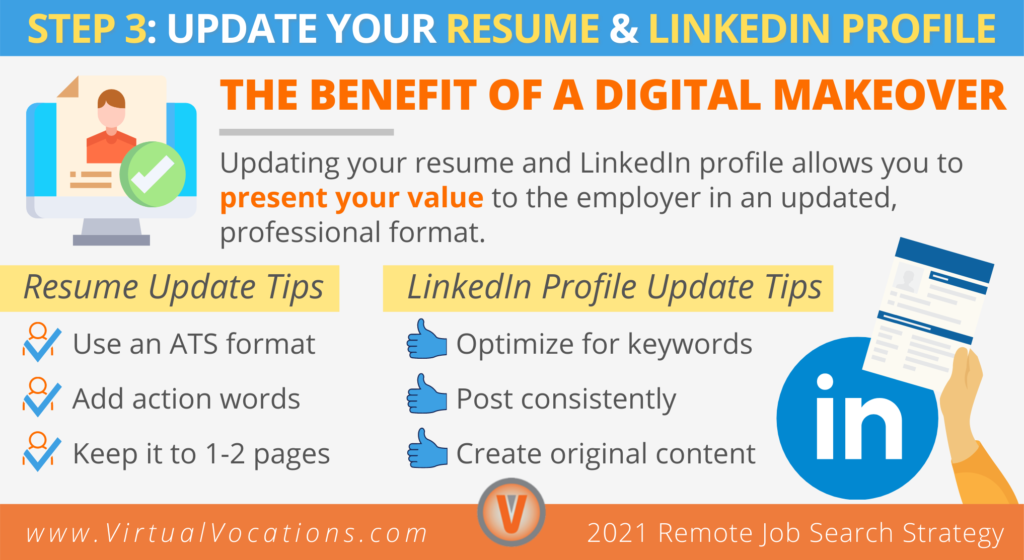
Update Your Resume and LinkedIn Profile
Now that you’ve identified your skills and quantified your experiences, the next step in your remote job search strategy is to present your value to the employer in an updated, professional format. But this extends beyond your resume to the professional social media platform, LinkedIn. In the digital age, many employers are now giving equal weight to your LinkedIn profile. As a result, you shouldn’t neglect your LinkedIn profile, but you also shouldn’t focus solely on it. Striking a balance between resume and LinkedIn updates is the only way to attract employers of all types.
How To Update Your Resume
Updating your resume isn’t as simple as it once was. You have numerous things to consider, including upgraded formatting (new fonts, colors, etc.), passing the applicant tracking system (ATS) software, adding keywords, and condensing it into one cohesive, easy-to-read document. So to update your resume successfully, follow these tips.
Keywords and Passing the ATS Test
To start, sift through job descriptions of your desired position and identify common word choices. Oftentimes, these are industry buzzwords that employers look for on resumes or through ATS software. This software is an automated tool that searches resumes for these keywords as well as additional information to save hiring managers and recruiters time.
Note: These keywords will vary by job and industry, so choosing a generic handful of these probably won’t pass the ATS test.
In addition, ATS software can get confused if you add in graphics, tables, and other stuff that’s meant to visually enhance your resume. Therefore, you’ll want to keep a more simplistic approach to your resume. Other tips for passing the ATS test include:
- Keep a single-column format
- Use a .doc or .txt file unless specifically asked for another format such as a .pdf
- Use all caps for section headings
- Include all necessary keywords
Other Tips to Update and Improve Your Resume
While customizing your resume for ATS software is important, don’t forget about the rest of your resume, especially if you haven’t updated it recently. To create the best resume possible:
- Add actionable words to your sentences
- Use active voice
- Rewrite your resume objective into a professional summary
- Include measurable, quantifiable results and statistics
- Add any remote skills or transferable remote skills (if you’re moving from a brick-and-mortar office to a virtual position)
- Keep your resume at one or two pages
- Remove your home address
- Omit college graduation dates (unless you’re a recent graduate) and work history more than 10+ years old, unless it’s relevant to the job you want
And if you need some extra help writing or updating a resume specifically for a remote job, make sure to check out Virtual Vocations Career Services.
How to Improve Your LinkedIn Profile
As another vital component of your remote job search strategy, your LinkedIn profile should look every bit as good as your resume. However, the online format may feel intimidating at first, but don’t let it get to you. It just takes the application of a few ideas and a bit of practice.
To begin, think of your LinkedIn profile as an extension of your resume. In fact, it contains many of the same content and optimization techniques. This includes:
- Optimizing for keywords
- Consistently updating when you apply to a new job or are searching for a new job
- Writing a professional summary
- Creating your own content instead of relying on templates
Conversely, LinkedIn profiles will also vary from your resume in a variety of ways. This is because of your profile’s expansive nature. It builds upon your resume and provides a bit of insight into who you are as both a person and professional. Therefore, some aspects found on your LinkedIn profile but not on your resume will include:
- A professional headshot and cover image
- More comprehensive information, such as a longer work history and other accomplishments or work examples
- A lead-in to help you create connections with recruiters and colleagues, even if you don’t land a specific job
Moreover, your LinkedIn profile should pass one simple question: If you looked at your own LinkedIn profile, would you hire yourself? If not, you may have to tweak a few aspects to increase your professionalism and hireability.
Other Social Media and Online Considerations
After you’ve updated your resume and LinkedIn profile, you’re almost at the finish line. If you’re feeling exhausted, don’t stress. This is the most time-consuming process of your remote job search strategy, and it may take up to five or six hours to be thorough. If you get discouraged, just remember that your new work from home job with all of its work-life balance and flexibility is worth the effort. That said, make sure to complete these final tasks:
- Obtain a professional-sounding email address, preferably with your name in the address and without any numbers or special characters
- Clean up your online presence and footprint. Complete this by deleting unprofessional photos from social media and using incognito mode on your browser to scrub the negative Google search results for your name.
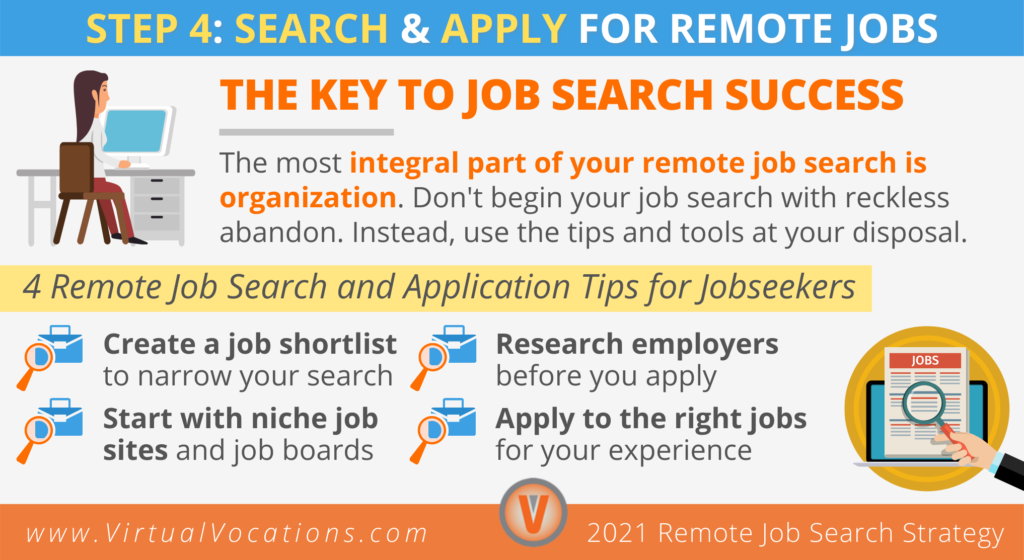
Search and Apply for Remote Jobs
Although updating your resume and LinkedIn profile are time-consuming tasks, the most difficult task in your remote job search strategy is searching and applying for jobs. But this shouldn’t cause you to shy away. Just follow these tips to streamline your job search and get your applications in ahead of other qualified candidates.
How To Search for Remote Jobs in One Word: Organization
Perhaps the most integral part of your remote job search is organization. Don’t just start your search off with reckless abandon. Instead, use the tools at your disposal. One highly recommended tool for this process is Virtual Vocations Job Search Tracker. As you search for jobs on Virtual Vocations, our website will automatically track your searches. From there, you can choose a daily, three times a week, or weekly job alert update in your email based on your previous searches. Alternatively, you can use Huntr, which is a free job search tool that tracks what jobs you’ve searched for and where you’ve applied.
Once you’ve narrowed your search or created a job shortlist, the next step is to dive into the job descriptions. Not only will these let you know if you’re qualified for the job or interested in the position, but it will also provide a wealth of keyword information for your tailored resume. Typically, these are industry buzzwords that are high-demand skills for a particular job or employer. Furthermore, you can use the required skills to further narrow down your search from a particular job title to a skill set.
Start With Niche Job Sites and Job Boards
If you just want to work remotely and don’t care what you’re doing, all-encompassing, generalized job boards such as Monster or Indeed will suffice. But if you know exactly what you want to do or even have a vague idea, start at the source: niche job sites and job boards. Unlike Monster and Indeed, Virtual Vocations does the legwork for you, vetting each employer so that only reputable, remote-only jobs remain.
You can also narrow down the job search portion of your remote job search strategy with specific sites that tailor to a single industry or profession. Some examples of these sites are:
- ProBlogger
- RemoteMedicalJobs
- Creative Circle
- Idealist.org
You should be able to find several other types of industry-specific job sites to suit your needs. Many of these sites require you to fill out an online profile and upload a resume. In this sense, the same principles of keywords and structure apply (just like your resume and LinkedIn profile).
Another important aspect of your job search is to set aside enough time every day. Budget one to three hours each day to search for jobs. This will yield more responses from employers from the jobs you want. If you’re forgetful or you don’t have as much time to devote to this as you’d like, set up a Virtual Vocations Job Alert that sends these job searches directly to your inbox.
Begin the Application Process
Don’t apply to so many jobs that you forget where you’ve applied for. If you’re organized, this shouldn’t become an issue. But you still may want to jot down some notes. Make sure to include when and where you applied to help you with the next step of your remote job search strategy: researching the company.
Research the Company
Unfortunately, you’re not going to gel with every company nor are you the fit for every organization. But that’s to be expected. Don’t let it discourage you. Instead, research the company before you apply. This will make you more inclined to apply with organizations where you’re a good cultural and personal fit. To start your search, you may want to check out reviews from former employees on sites such as:
- Glassdoor
- Fairygodboss
- JobAdvisor
- Vault
Surprisingly, Yelp is also a valuable tool for some businesses. This allows you to see how your prospective employer handles customer relations—a superb insight into their values and overall culture.
Note: Keep in mind that a bad review shouldn’t necessarily eliminate an employer from contention. Sometimes, disgruntled employees and hard-to-please customers can lower their star rating without validity.
If the company passes the employee and customer review test, you should brush up on all relevant information about the company. Not only will this show initiative, but it will also demonstrate proactive behavior that employers constantly look for. Make sure to familiarize yourself with:
- Where the company is located
- Number of employees and whether they’re 100% remote
- Core values, vision and mission statements
- Exactly what they do
- Any proprietary products they own/have and services provided
- Who their clients are
Remember that you’ll revisit this when you prepare for an interview. But doing so in advance can eliminate any doubts in your mind about a potential problem fitting in with the culture—or worse—a disreputable employer.
Apply to the Right Jobs
Once you’ve identified a few jobs that interest you that you could potentially get, the application process begins. Don’t make the mistake of so many other jobseekers: sending generic cover letters and the same resume to every job. Hiring managers can spy these from the second they hit their inbox. And most hit delete a few seconds into reading.
That’s why you should always, always tailor both your cover letter and resume to each individual job. Not only does this allow you to target relevant keywords, but it also highlights your pertinent experiences/education, as well as adding a bit of personality that separates you from the pack of other candidates. While this requires more time and effort, the results are worth it. The hiring manager or recruiter will notice.

Pro Tip: In your cover letter, don’t use the generic “Dear Hiring Manager” or something of the like. Instead, go the extra mile. When you’re researching the company, use their website or LinkedIn page to find the name of the actual hiring manager or recruiter. This shows the initiative that companies look for, as well as starting off on the right foot. If you’re unsure, you can always send an email to the employer to find out who to address your cover letter to.
And don’t forget to follow up if you don’t hear anything back!
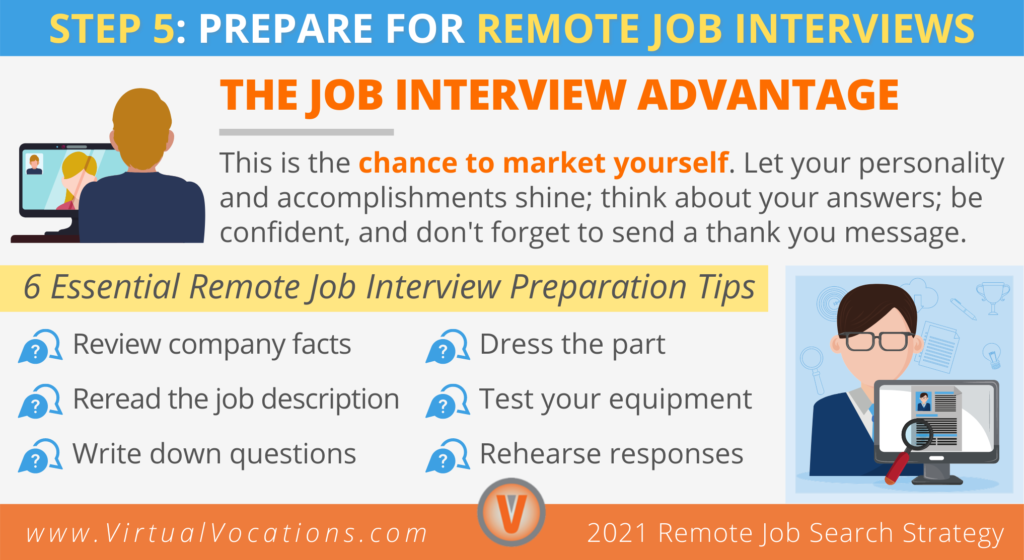
Prepare for Interviews
So you’ve updated your resume, cleaned up your social media, done your research, and diligently applied to jobs. Now it’s time for the final step in your remote job search strategy: preparing for your interview. While interviews conjure up feelings of anxiety and dismay, going in with the proper research of the company and a general interest in the job are your greatest allies. They help you exude confidence while also providing an upbeat demeanor—two irresistible qualities to employers.
So how do you prepare for an interview? While this preparation depends on the job and industry, follow these basic tips to point you in the right direction:
- Do the research: Review the research listed above so everything’s fresh in your mind.
- Go over the job description so you know what your roles and responsibilities are.
- Formulate any questions you have for the interviewer and write them down.
- You may want to rehearse potential questions, but don’t become a mundane, robotic interviewee.
- Find a distraction-free place for the interview.
- Decorate your background accordingly.
- Dress the part.
- Test all of your equipment and have your phone as a backup hot spot in case your internet goes down.
If you have all this together, you’re ready for the interview. But don’t forget one crucial thing: this is your one big chance to market yourself. Let your accomplishments and your personality shine without bragging. Take a few seconds to think about your answers. Always be confident in what you say. And don’t forget to send a thank you following the meeting.
The Remote Job Search Strategy: The Final Keys to Success
A remote job search strategy is just one part of the total blueprint for the professional in you in 2021. But don’t be complacent with this alone. Put your best foot forward, be curious, and always look for ways to better yourself professionally. With this mix of attributes, you just might find that 2021 is the year you land the remote job that changes your life. That should be enough to motivate you.
Jump-Start Your Remote Job Search Strategy With the Virtual Vocations Remote Career Plan
If you’re searching for ways to get organized in your remote job search strategy, check out the Virtual Vocations Remote Career Plan. With actionable tips and suggestions, this fillable, printable PDF is a great way to get a jump-start on your remote job search in 2021.
What types of remote jobs are you looking for in 2021? How will you apply this remote job search strategy to your pursuit of the perfect job? Connect with Virtual Vocations on Facebook, Twitter, LinkedIn, Instagram, and YouTube to share your thoughts and questions. We’d love to hear from you!

Join Virtual Vocations Today!
Before you implement your job search strategy, make sure to use our Remote Career Plan. With this fillable, printable PDF, you can successfully prepare for and navigate your remote job search.
Joining Virtual Vocations grants you access to our hand-picked telecommuting jobs database. Learn how our service works, browse job leads by location and career category, or search hundreds of hand-screened telecommuting jobs to find legitimate work-at-home job leads that match your skills and background. Register for free or contact us for more information on our service guarantee.
Check out our menu of Career Services provided by our team of certified professionals, including resume and career coaching services for remote jobseekers. Resume assessments and writing, LinkedIn profile enhancement, and cover letter writing are available to maximize the success of your remote job applications. Discounts on all services available to subscription members, become one now.













